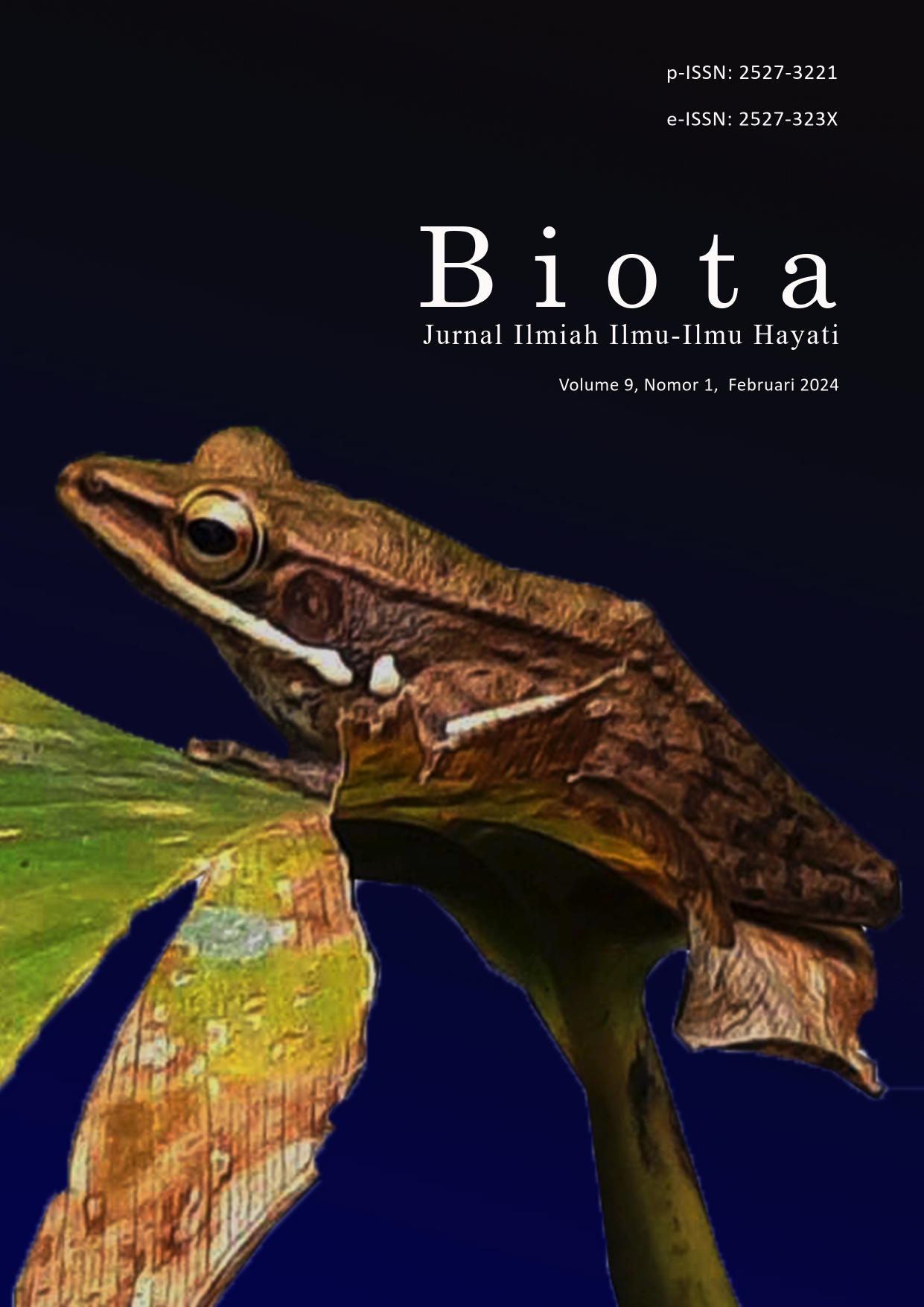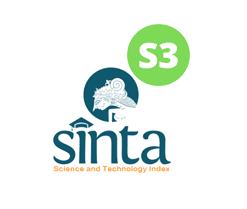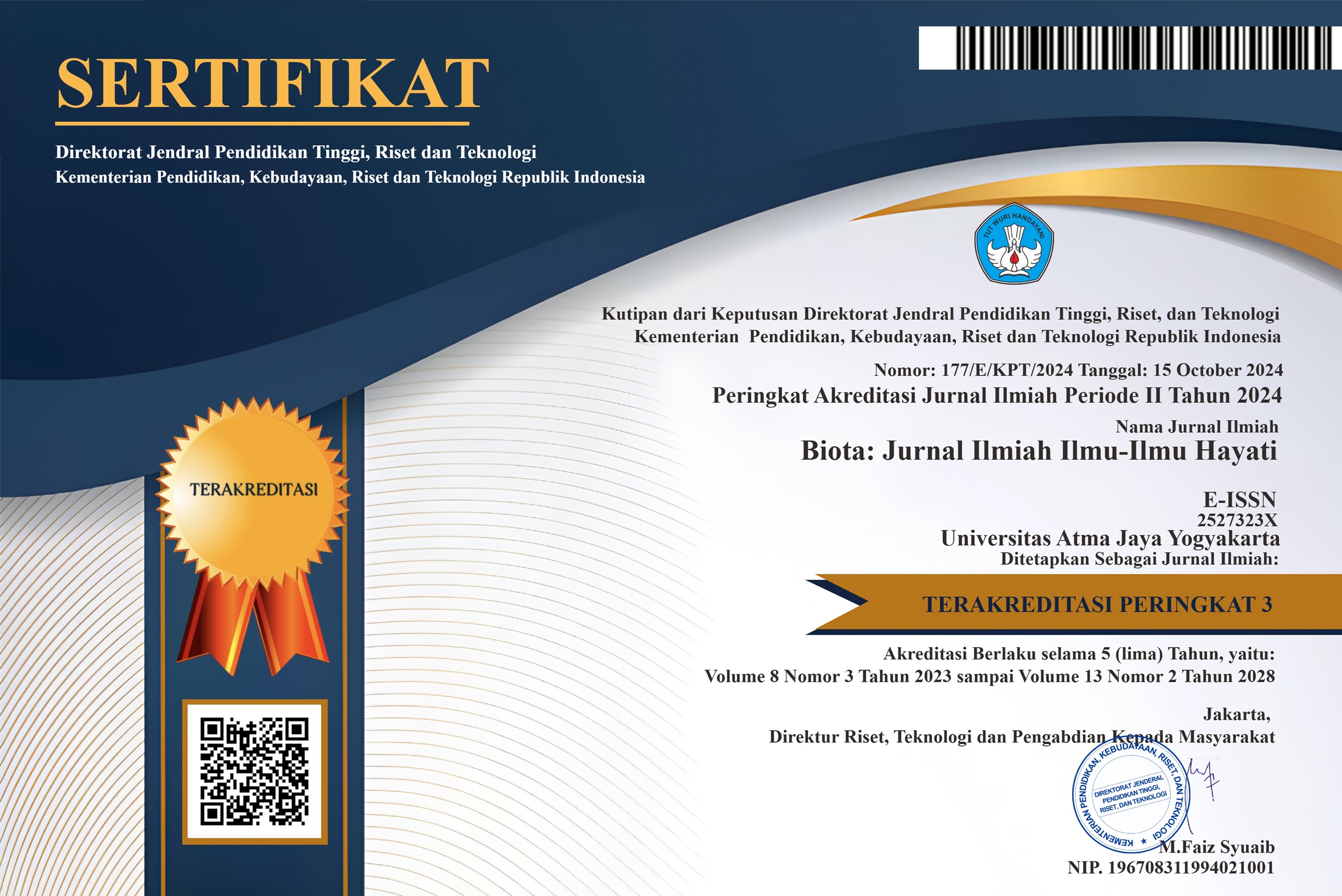Cell Surface and Adherence Properties of Indonesian Indigenous Lactic Acid Bacteria as Probiotic Candidate
DOI:
https://doi.org/10.24002/biota.v9i1.8124Keywords:
adherence, aggregation, hydrophobicity, intestinal mucosa, probioticAbstract
Adherence to intestinal mucosa is one of the crucial probiotic traits. This ability varied among strains. This study aims to evaluate the cell surface properties and adherence potential of Indonesian Indigenous LAB. The adherence potential was evaluated using auto- aggregation, coaggregation against Salmonella, cell hydrophobicity, and adherence to stainless-steel surface. All strains classified as having medium high aggregation (>90%) after 24 h of incubation and can coaggregate with Salmonella (58-92%). Among all strains, Levilactobacillus brevis AB3 showed the highest hydrophobicity (36%) and adhesion to stainless steel (6.37 log CFU/mL). Current findings suggest that Indonesian Indigenous LAB, especially L. brevis AB3, possessed an adherence property and has a potential to be developed into probiotic bacteria.
References
Amelia, R., Philip, K., Pratama, Y. E., & Purwati, E. (2021). Characterization and probiotic potential of lactic acid bacteria isolated from dadiah sampled in West Sumatra. Food Science and Technology (Brazil), 41, 746–752.
Aziz, G., Fakhar, H., Rahman, S. ur, Tariq, M., & Zaidi, A. (2019). An assessment of the aggregation and probiotic characteristics of Lactobacillus species isolated from native (desi) chicken gut. Journal of Applied Poultry Research 28(4): 846–857.
Collado, M. C., Meriluoto, J., & Salminen, S. (2008). Adhesion and aggregation properties of probiotic and pathogen strains. European Food Research and Technology 226(5): 1065–1073.
Da Cruz Rodrigues, V. C., Rocha Faria Duque, A. L., De Carvalho Fino, L., Simabuco, F. M., Sartoratto, A., Cabral, L. lia, Noronha, M. F., Sivieri, K., & Antunes, A. E. C. (2020). Modulation of the intestinal microbiota and the metabolites produced by the administration of ice cream and a dietary supplement containing the same probiotics. British Journal of Nutrition, 124(1), 57–68.
Darmastuti, A., Hasan, P. N., Wikandari, R., Utami, T., Rahayu, E. S., & Suroto, D. A. (2021). Adhesion properties of lactobacillus plantarum dad-13 and lactobacillus plantarum mut-7 on sprague dawley rat intestine. Microorganisms 9(11): 1-12.
Deepika, G., & Charalampopoulos, D. (2010). Surface and Adhesion Properties of Lactobacilli. Advances in Applied Microbiology 70(4): 127–152.
Dertli, E., Mayer, M. J., & Narbad, A. (2015). Impact of the exopolysaccharide layer on biofilms, adhesion and resistance to stress in Lactobacillus johnsonii FI9785. BMC Microbiology 15(8): 1-8.
Dlamini, Z. C., Langa, R. L. S., Aiyegoro, O. A., & Okoh, A. I. (2019). Safety Evaluation and Colonisation Abilities of Four Lactic Acid Bacteria as Future Probiotics. Probiotics and Antimicrobial Proteins 11(2): 397-402.
Dutta, D., Banerjee, S., Mukherjee, A., & Ghosh, K. (2018). Potential gut adherent probiotic bacteria isolated from Rohu, Labeo rohita (Actinopterygii: Cypriniformes: Cyprinidae): Characterisation, exo-enzyme production, pathogen inhibition, cell surface hydrophobicity, and bio-film formation. Acta Ichthyologica et Piscatoria, 48(3): 221–233.
Fadda, M. E., Mossa, V., Deplano, M., Pisano, M. B., & Cosentino, S. (2017). In vitro screening of Kluyveromyces strains isolated from Fiore Sardo cheese for potential use as probiotics. LWT 75: 100–106.
Febriana, M. H., Purwijantiningsih, E., & Yuda, P. (2021). Identifikasi dan Uji Aktivitas Antimikrobia Bakteri Asam Laktat dari Fermentasi Singkong (Gatot) terhadap Bacillus cereus dan Aspergillus flavus. Biota : Jurnal Ilmiah Ilmu-Ilmu Hayati 6(1): 15–24.
Food and Agriculture Organization of the United Nations., & World Health Organization. (2006). Probiotics in food : health and nutritional properties and guidelines for evaluation. Food and Agriculture Organization of the United Nations.
Fukao, M., Zendo, T., Inoue, T., Nakayama, J., Suzuki, S., Fukaya, T., Yajima, N., & Sonomoto, K. (2019). Plasmid-encoded glycosyltransferase operon is responsible for exopolysaccharide production, cell aggregation, and bile resistance in a probiotic strain, Lactobacillus brevis KB290. Journal of Bioscience and Bioengineering 128(4): 391–397.
Grigoryan, S., Bazukyan, I., & Trchounian, A. (2018). Aggregation and Adhesion Activity of Lactobacilli Isolated from Fermented Products In Vitro and In Vivo: a Potential Probiotic Strain. Probiotics and Antimicrobial Proteins 10(2): 269–276.
Harahap, I. A., Mariyatun, M., Hasan, P. N., Pamungkaningtyas, F. H., Widada, J., Utami, T., Cahyanto, M. N., Juffrie, M., Dinoto, A., Nurfiani, S., Zulaichah, E., Sujaya, I. N., & Rahayu, E. S. (2021). Recovery of Indigenous probiotic Lactobacillus plantarum Mut-7 on healthy Indonesian adults after consumption of fermented milk containing these bacteria. Journal of Food Science and Technology, 58(9), 3525–3532.
Harnentis, H., Marlida, Y., Nur, Y. S., Wizna, W., Santi, M. A., Septiani, N., Adzitey, F., & Huda, N. (2020). Novel probiotic lactic acid bacteria isolated from indigenous fermented foods from West Sumatera, Indonesia. Veterinary World 13(9): 1922–1927.
Hojjati, M., Behabahani, B. A., & Falah, F. (2020). Aggregation, adherence, anti-adhesion and antagonistic activity properties relating to surface charge of probiotic Lactobacillus brevis gp104 against Staphylococcus aureus. Microbial Pathogenesis 147(2020): 1-9.
Hossain, M. N., Senaka Ranadheera, C., Fang, Z., Masum, A. K. M., & Ajlouni, S. (2022). Viability of Lactobacillus delbrueckii in chocolates during storage and in-vitro bioaccessibility of polyphenols and SCFAs. Current Research in Food Science 5: 1266–1275.
Janković, T., Frece, J., Abram, M., & Gobin, I. (2012). Aggregation ability of potential probiotic Lactobacillus plantarum strains. In International Journal of sanitary engineering research 6(1): 19-24.
Juntarachot, N., Sunpaweravong, S., Kaewdech, A., Wongsuwanlert, M., Ruangsri, P., Pahumunto, N., & Teanpaisan, R. (2023). Characterization of adhesion, anti-adhesion, co-aggregation, and hydrophobicity of Helicobacter pylori and probiotic strains. Journal of Taibah University Medical Sciences 18(5): 1048–1054.
Kim, J. H., Lee, E. S., Song, K. J., Kim, B. M., Ham, J. S., & Oh, M. H. (2022). Development of Desiccation- Tolerant Probiotic Biofilms Inhibitory for Growth of Foodborne Pathogens on Stainless Steel Surfaces. Foods 11(6): 1-11.
Krausova, G., Hyrslova, I., & Hynstova, I. (2019). In vitro evaluation of adhesion capacity, hydrophobicity, and auto-aggregation of newly isolated potential probiotic strains. Fermentation 5(4): 1-11.
Krishnan, V., Chaurasia, P., & Kant, A. (2016). Pili in Probiotic Bacteria. In Probiotics and Prebiotics in Human Nutrition and Health 1(1): 115-133.
Kumar, R., Bansal, P., Singh, J., Dhanda, S., & Bhardwaj, J. K. (2020). Aggregation, adhesion and efficacy studies of probiotic candidate Pediococcus acidilactici NCDC 252: a strain of dairy origin. World Journal of Microbiology and Biotechnology 36(1): 1-15.
Maciel, M., De Oliveira, M., Florisvaldo Brugnera, D., Alves, ; Eduardo, & Piccoli, R. H. (2010). Biofilm Formation by Listeria monocytogenes On Stainless Steel Surface and Biotransfer Potential. Brazilian Journal of Microbiology 41: 97–106.
Manvelyan, A., Balayan, M., Miralimova, S., Chistyakov, V., & Pepoyan, A. (2023). Biofilm formation and auto-aggregation abilities of novel targeted aqua-probiotics. Functional Foods in Health and Disease, 13(4): 179–190.
Monteagudo-Mera, A., Rastall, R. A., Gibson, G. R., Charalampopoulos, D., & Chatzifragkou, A. (2019). Adhesion mechanisms mediated by probiotics and prebiotics and their potential impact on human health. In Applied Microbiology and Biotechnology 103(16): 6463–6472.
Mulaw, G., Sisay Tessema, T., Muleta, D., & Tesfaye, A. (2019). In vitro evaluation of probiotic properties of lactic acid bacteria isolated from some traditionally fermented ethiopian food products. International Journal of Microbiology 2019: 1-11.
Muscariello, L., De Siena, B., & Marasco, R. (2020). Lactobacillus Cell Surface Proteins Involved in Interaction with Mucus and Extracellular Matrix Components. In Current Microbiology 77(12): 3831– 3841.
Qureshi, N., Gu, Q., & Li, P. (2020). Whole genome sequence analysis and in vitro probiotic characteristics of a Lactobacillus strain Lactobacillus paracasei ZFM54. Journal of Applied Microbiology 129(2): 422–433.
Ramadhanti, N., Melia, S., Hellyward, J., & Purwati, E. (2021). Characteristics of lactic acid bacteria isolated from palm sugar from West Sumatra, Indonesia and their potential as a probiotic. Biodiversitas, 22(5), 2610–2616.
Re, B. Del, Sgorbati, B., Miglioli, M., & Palenzona, D. (2000). Adhesion, autoaggregation and hydrophobicity of 13 strains of Bifidobacterium longum. Letters in Applied Microbiology 31: 438–442.
Reda, F. M. (2019). Antibacterial and anti-adhesive efficiency of Pediococcus acidilactici against foodborne biofilm producer Bacillus cereus attached on different food processing surfaces. Food Science and Biotechnology 28(3): 841–850.
Rickard, A. H., Gilbert, P., High, N. J., Kolenbrander, P. E., & Handley, P. S. (2003). Bacterial coaggregation: An integral process in the development of multi-species biofilms. In Trends in Microbiology 11(2): 94–100.
Rokana, N., Singh, B. P., Thakur, N., Sharma, C., Gulhane, R. D., & Panwar, H. (2018). Screening of cell surface properties of potential probiotic lactobacilli isolated from human milk. Journal of Dairy Research 85(3): 347–354.
Romaniuk, J. A. H., & Cegelski, L. (2018). Peptidoglycan and Teichoic Acid Levels and Alterations in Staphylococcus aureus by Cell-Wall and Whole-Cell Nuclear Magnetic Resonance. Biochemistry 57(26): 3966–3975.
Sumarni, D. (2011). Karakteristik Penempelan dan Koagregasi Bakteri Asam Laktat Indigenous Dadiah dan Yogurt sebagai Kandidat Probiotik pada Usus Halus Tikus in vitro [Bachelor’s Thesis]. IPB University. Bogor.
Yusuf, D., Nuraida, L., Dewanti-Hariyadi, R., & Hunaefi, D. (2020). In Vitro Characterization of Lactic Acid Bacteria from Indonesian Kefir Grains as Probiotics with Cholesterol-Lowering Effect. Journal of Microbiology and Biotechnology, 30(5), 726–732.
Downloads
Published
How to Cite
Issue
Section
License
Copyright (c) 2024 Benediktus Yudo Leksono, Ekawati Purwijantiningsih, Gracia Irene Benaya Wibisono

This work is licensed under a Creative Commons Attribution-NonCommercial 4.0 International License.
Authors who publish with Biota : Jurnal Ilmiah Ilmu-Ilmu Hayati agree to the following terms:
- Authors retain copyright and grant the Biota : Jurnal Ilmiah Ilmu-Ilmu Hayati right of first publication. Licensed under a Creative Commons Attribution-NonCommercial 4.0 International License that allows others to share the work with an acknowledgment of the work's authorship and initial publication in this journal.
- Authors are able to enter into separate, additional contractual arrangements for the non-exclusive distribution of the journal's published version of the work (e.g., post it to an institutional repository or publish it in a book), with an acknowledgment of its initial publication in Biota : Jurnal Ilmiah Ilmu-Ilmu Hayati, and as long as Author is not used for commercial purposes.













